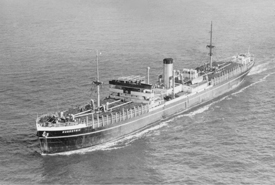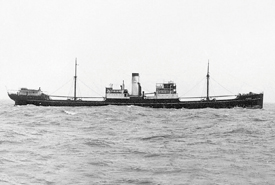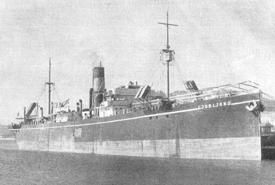
S/S NERETVA had a respectable 45 years of service when acquired. She was employed for transporting phosphates from Morocco to Great Britain. (Photo: Fotoflite, Ashford, UK)
|
Length: 108.3 m |
Breadth: 15.5 m |
Deadweight: 6,663 tons |
Steam engine: 1,217 kW |
|
Built: 1911 |
Sold: 1959 |
Scrapped: 1960 in Kawasaki, Japan |
The Steamship Period
Upon the decentralization of the Yugoslavian merchant marine in 1956, six vessels were allocated to Splošna Plovba: Gorica (I), Ljubljana (I), Bihać, Dubrovnik, Neretva and Kornat. The total fleet deadweight was thus increased for 50,529 tons. All six steamships were in relatively poor technical condition, with an average age of nearly 39 years, and speed from 8 to 9.5 knots. In the II. World War all six were actively employed by the Allies, some even in the I. World War. With the exception of steamship Ljubljana, their boilers were modified to run on heavy fuel.
With the allocation of these vessels and the purchase of the "Liberty type" secondhand vessels, within a short period, Splošna Plovba began to assert itself in the tramp trade at a global level. A large number of Slovenian seafarers commenced their maritime careers on board these ships.
S/S DUBROVNIK was employed for transporting various cargoes in the tramp trade. She was sold in the then East Pakistan where she was used in Chittagong for discharging grain from larger vessels. (Photo: Fotoflite, Ashford, UK)
|
Length: 136.8 m |
Breadth: 17.1 m |
Deadweight: 9,150 tons |
|
Steam engine: 1,213 kW |
Built: 1938 |
Sold: 1969 |
|
Scrapped: 1969 |
|
|
S/S KORNAT was a typical cargo ship built during the I. World War. During repairs in Liverpool in 1944, she was badly damaged due to the ingress of water into the dry-dock. In 1949, extensive repairs to her hull, engines and crew quarters were made. She was employed for transporting various cargoes.
|
Length: 125.9 m |
Breadth: 15.9 m |
Deadweight: 8,172 tons |
|
Steam engine: 1,901 kW |
Built: 1918 |
Sold: 1957 |
|
Scrapped: 1963 in Osaka, Japan |
|
|
S/S LJUBLJANA (I) built in England for the Austro-Hungarian merchant marine, was powered by coal throughout her lifetime. Her coal consumption was 40 tons of high quality coal per day stoked up by 9 firemen and 3 coalmen. She was employed by Splošna Plovba for transporting coal from the Black Sea for the Yugoslavian coke industry. The photograph dates back to 1946 in Split. Clearly seen are the funnel marks of the previous owner, the shipping company Oceania from Sušak. Also visible are the additional life rafts and the observation post on the mast from the war period.
|
Length: 119.1 m |
Breadth: 16.2 m |
Deadweight: 8,026 tons |
|
Steam engine: 1,323 kW |
Built: 1912 |
Sold: 1963 |
|
Scrapped: 1963 in Split |
|
|






